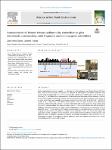Contamination of Thames Estuary sediments by retroreflective glass microbeads, road marking paint fragments and anthropogenic microfibres
| dc.contributor.author | West-Clarke, Z | |
| dc.contributor.author | Turner, A | |
| dc.date.accessioned | 2024-01-19T12:46:51Z | |
| dc.date.issued | 2024-02-20 | |
| dc.identifier.issn | 0048-9697 | |
| dc.identifier.issn | 1879-1026 | |
| dc.identifier.other | 169257 | |
| dc.identifier.uri | https://pearl.plymouth.ac.uk/handle/10026.1/21923 | |
| dc.description.abstract |
Surface and subsurface sediment samples (n = 16) from the highly urbanised inner Thames Estuary (UK) have been physically and chemically characterised and analysed for anthropogenic microdebris. Sediments were gravelly sands throughout and were heavily contaminated by lead (Pb, up to 12,500 mg kg−1) and zinc (Zn, up to 9500 mg kg−1). Microfibres of mm-dimensions and retroreflective glass microbeads (median diameter = 188 μm) used in road markings were the most abundant types of microdebris present, and concentrations (as numbers, N) on a dry weight basis were spatially heterogeneous (ranging from about 4000 to 60,000 N kg−1 and 100 to 28,000 N kg−1, respectively). Nevertheless, concentrations of the two types of particle were significantly correlated and both displayed an inverse, non-linear relationship with sediment grain size. Road marking paint fragments of different colours were detected in most cases (n = 13) but quantification was difficult because of analytical constraints related to size, shape, colour, fragmentation and encrustation. Concentrations of up to about 500 mg kg−1 Pb were determined in isolated paint fragments but road paint particles are unlikely to make a significant contribution to Pb pollution in Thames Estuary sediments. Overall, our observations suggest that stormwater runoff is a significant source of multiple types of anthropogenic microdebris in urban estuaries, with additional, direct atmospheric deposition contributing to microfibre accumulation. More generally, it is recommended that studies of microplastics consider additional debris and sediment characteristics for a better understanding of their sources and transport. | |
| dc.format.extent | 169257-169257 | |
| dc.format.medium | Print-Electronic | |
| dc.language | en | |
| dc.publisher | Elsevier BV | |
| dc.subject | Pollution | |
| dc.subject | Urban | |
| dc.subject | Microplastics | |
| dc.subject | Lead | |
| dc.subject | Stormwater | |
| dc.subject | Microdebris | |
| dc.title | Contamination of Thames Estuary sediments by retroreflective glass microbeads, road marking paint fragments and anthropogenic microfibres | |
| dc.type | journal-article | |
| dc.type | Article | |
| plymouth.author-url | https://www.ncbi.nlm.nih.gov/pubmed/38128660 | |
| plymouth.volume | 912 | |
| plymouth.publication-status | Published | |
| plymouth.journal | Science of The Total Environment | |
| dc.identifier.doi | 10.1016/j.scitotenv.2023.169257 | |
| plymouth.organisational-group | |Plymouth | |
| plymouth.organisational-group | |Plymouth|Research Groups | |
| plymouth.organisational-group | |Plymouth|Faculty of Science and Engineering | |
| plymouth.organisational-group | |Plymouth|Faculty of Science and Engineering|School of Geography, Earth and Environmental Sciences | |
| plymouth.organisational-group | |Plymouth|Research Groups|Marine Institute | |
| plymouth.organisational-group | |Plymouth|REF 2021 Researchers by UoA | |
| plymouth.organisational-group | |Plymouth|Users by role | |
| plymouth.organisational-group | |Plymouth|Users by role|Academics | |
| plymouth.organisational-group | |Plymouth|Research Groups|BEACh | |
| plymouth.organisational-group | |Plymouth|REF 2021 Researchers by UoA|UoA07 Earth Systems and Environmental Sciences | |
| plymouth.organisational-group | |Plymouth|REF 2028 Researchers by UoA | |
| plymouth.organisational-group | |Plymouth|REF 2028 Researchers by UoA|UoA07 Earth Systems and Environmental Sciences | |
| dc.publisher.place | Netherlands | |
| dcterms.dateAccepted | 2023-12-07 | |
| dc.date.updated | 2024-01-19T12:46:50Z | |
| dc.rights.embargodate | 2024-1-20 | |
| dc.identifier.eissn | 1879-1026 | |
| rioxxterms.versionofrecord | 10.1016/j.scitotenv.2023.169257 |


